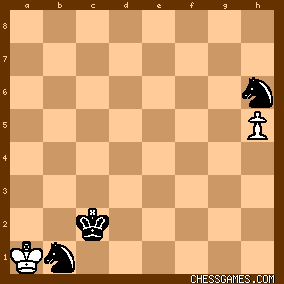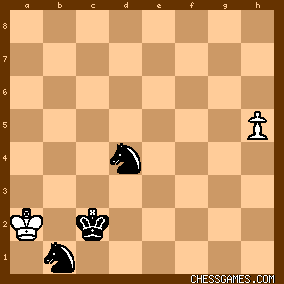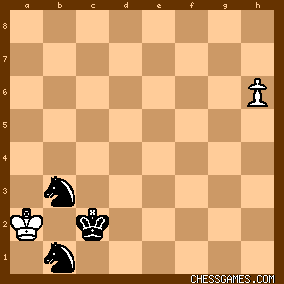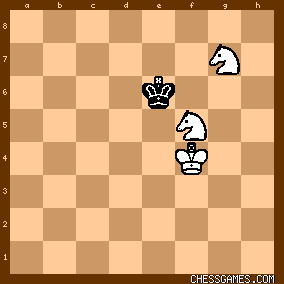|
< Earlier Kibitzing · PAGE 3 OF 4 ·
Later Kibitzing> |
| Sep-18-15 | | The Kings Domain: Boy, this is a long game. |
|
Jan-07-17
 | | FSR: 85...Nf5 86.Ka2 (86.h6 Nc3 87.h7 Nd4 88.h8=Q Nb3#) Nd4 87.h6 Nb3 88.h7 Nc1+ 89.Ka1 Nc3 90.h8=Q Nb3#. |
|
| Jan-07-17 | | Big Pawn: Got to stalemate the king and then mate with the other knight. I had it
85...Nf5
86. Ka2 (if 86. h7 then ...Nc3 holds the king still until mate is delivered on b3) Nd4 87. h6 Nc6
88. Ka1 Nb4 (mating net)
89. h7 Nd2
90. h8 Nb3# |
|
Jan-07-17
 | | FSR: Bled to Death. |
|
Jan-07-17
 | | perfidious: <FSR: Bled to Death.> Somehow, the alternative <Veldes to Death> does not have quite the same ring to it. |
|
Jan-07-17
 | | An Englishman: Good Evening:Might have missed something--thought the solution consisted of 85...Nd2; 86.Ka2,Nc5; 87.Ka1,Nf5; 88.h6,Nd4; 89.h7,Nb3+; 90.Ka2,Nc1+; 91.Ka1,Nd2; 92.h8/Q,Nb3. What did I overlook? |
|
| Jan-07-17 | | YouRang: Saturday 85...?

click for larger view
I was a bit surprised to see a basic K+P vs K+2N ending. In general, this is an excruciatingly difficult ending to win. However, in this case, most of the hard work has been done. The white king has been cornered and its mobility reduced to two squares using just the king and one knight. The other knight is blocking the pawn, awaiting this moment. The white pawn is actually necessary for black to win, as it prevents white from drawing via stalemate. The first move is pretty self-evident: <85...Nf5>. This knight is beginning its mad dash to checkmate the king before the pawn can promote and save the king.

click for larger view
White is left with two choices:
- Black is probably hoping that white will push the pawn, because that makes it easy: <86.h6 Nc3!> immobilizing the king, and thus forcing <86.h7 87.Nd4 h8Q 88.Nb3# - easy. - White makes it a little harder by moving the king: <86.Ka2 Nd4>

click for larger view
Now white has to push the pawn, since 87.Ka1 loses as above: 87...Nc3 88.h6 Nb3#. So, <87.h6 Nb3>

click for larger view
This would be stalemate except that white has that (darn) pawn which must be pushed: <88.h7>, and now the mate is forced easily: <88...Nc1+ 89.Ka1 Nc3 90.h8Q Nb3#> Fairly easy for a Saturday puzzle. |
|
| Jan-07-17 | | YouRang: <An Englishman: Good Evening:Might have missed something--thought the solution consisted of 85...Nd2; 86.Ka2,Nc5; 87.Ka1,Nf5; 88.h6,Nd4; 89.h7,Nb3+; 90.Ka2,Nc1+; 91.Ka1,Nd2; 92.h8/Q,Nb3. What did I overlook?> This works, but you made it a little complicated by moving the Nb1 to c4 so that you could bring the Nh6 to b1. You could just leave the Nb1 where it is. |
|
Jan-07-17
 | | Dionysius1: Very pleased with myself - I got it at 0715 - maybe I'm beginning to think better in the mornings of my rapidly advancing old age. |
|
| Jan-07-17 | | patzer2: In the Saturday puzzle position it's mate-in-five after 85...Nf5 86. Ka2 (86. h6 Nc3 87. h7 Nd4 88. h8=Q Nb3#) 86... Nd4 87. h6 Nb3 88. h7 Nc1+ 89. Ka1 Nd2 90. h8=Q Ndb3#. Where did White first go wrong in trying to save the draw in this pawn versus two knights endgame? <David 2009> in his April 2009 post correctly points out 69. Ka2? is the initial error that allows Black to mate within the 50-move rule. The online table base at http://chessok.com/?page_id=361 indicates 69. Ka2? allows mate-in-31 after 69...Kc3  (not the game move 69...Ke3? 70. Kb3 (not the game move 69...Ke3? 70. Kb3  taking it out with perfect play to an 81 move mate). taking it out with perfect play to an 81 move mate). Instead, 69...Ka4 70. Kc5  stretches it to mate-in-80 with a technical draw since there is no exchange of material for the first 50 moves of this mating combination. stretches it to mate-in-80 with a technical draw since there is no exchange of material for the first 50 moves of this mating combination. P.S.: I'm assuming the 50-move rule was in effect in 1961 when this game was played. The strict 50-move rule has been in effect in FIDE since 1992, but there were some exceptions allowed prior to that according to https://en.wikipedia.org/wiki/Fifty.... |
|
| Jan-07-17 | | wtpy: Hadn't gone to sleep yet and got the first three moves and then went down a wrong path. This is a case where it could aid a player to write a note about which knight goes where, but chess rules wont let you. As Kilgore Trout would say: "So it goes." |
|
| Jan-07-17 | | NBZ: The obvious move is 85. ... Nf5 hoping for h6.
(1) After 85. ... Nf5 86. h6? Nxh6 is a draw after 87. Ka2 Nf5 88. Ka1 Nd4 89. Ka2 with a mutual zugzwang. With two knights on the board, White has no way to lose a tempo.
(2) But after 85. ... Nf5 86. h6? Nc3! 87. h7 Nd4 and mate on b3. However, White can meet 85. ... Nf5 by 86. Ka2! Now there does not seem to be a win: for example 86. ... Nd4 h6 and Black only has a perpetual with 87. Nb3 h7 88. Nc1+ Ka1 89. Nb3+. Let's do first things first: Black can use the restricted position of the White king to improve the position of his knight. So let's play 85. ... Nd2! 86. Ka2 Nc4 87. Ka1 Nd6 88. Ka2 Nb5 89. Ka1 
click for larger viewAlmost the same as the starting position, except the White knight on b5 does everything it did on b1 in addition to having the option of swivelling over to the d4 square. Now we will try Nf5 again. 89. ... Nf5 90. Ka2! (90. h6 loses just as before) Ne3! 91. h6 Nd1 92. h7 Ndc3+ 93. Ka1 Nd4 94. h8=Q Nb3#. Very pretty line if it works. The knight on b1 gives mate from b3: hardly what I expected when I first looked at the position. |
|
| Jan-07-17 | | NBZ: I see that I mucked up the obvious line, and found a way to delay the mate by 4 moves. At least it's still well within the 50 moves rule :) |
|
| Jan-07-17 | | AlicesKnight: I was a little surprised that 86.h6 was not tried, but <YouRang> seems to have it right. |
|
| Jan-07-17 | | lost in space: Got that right away |
|
| Jan-07-17 | | gofer: This was far to easy for a <Saturday>. A forced mate in six moves is hardly rocket science! All you have to work out is that once the king is on a2, the best checking square for the "mobile" knight is c1. From there you simply have to find a path to reach c1 and then count the number of moves. If the h pawn promotes before the check on c1, then its a draw if it doesn't then its a win... 85 ... Nf5
86 Ka2 Nd4
87 h6 Nb3/Ne2
88 h7 Nc1+
89 Ka1 Nd2
90 h8=Q Nb3# |
|
| Jan-07-17 | | agb2002: Black has two knights for a pawn.
Black can deliver mate with 85... Nf5:
A) 86.h6 Nc3 87.h7 Nd4 88.h8=Q Nb3#.
B) 86.Ka2 Nd4 87.h6 (87.Ka1 Nc3 as above) 87... Nb5 88.h7 Nc3+ 89.Ka1 Nd4 90.h8=Q Nb3#. |
|
| Jan-07-17 | | morfishine: Another solution is the maneuver Nd2-f1-g3 followed by Nxh5; White would then be free to execute the 2N mate in 379 moves subsequent to the obligatory opponent's blunder ***** |
|
| Jan-07-17 | | thegoodanarchist: This is great - I can replay a game from 55 years ago whenever I want. Can I replay any and every pro soccer or football or basketball (or baseball or whatever) game from 1955, whenever I want? I might get lucky and find it on youtube, or most likely no. But with chess? Close to 90% or more of them, and this one is a treat. |
|
Jan-07-17
 | | Sally Simpson: 
click for larger viewJust one of the great attractions of Chess. With the pawn on h5 it is a win. With no pawn on h5 it is a draw. Won a pint once in Sandy Bells by saying I could mate with two Knights v a bare King. The lad was positive no such position could be set up unless it was in the corner of the board. 
click for larger view1.Nb6+ Kc8 2.Ne6 mate.

click for larger viewNot forced but it is checkmate. Which brings us on nicely to Kotov vs Najdorf, 1953 
click for larger viewKotov wanted to play on explaining to the perplexed Najdorf that a Siberian amateur had worked out a forced mate with the two Knights. (see thread) |
|
| Jan-07-17 | | YouRang: It looks like black could have unleashed his Nh6 a couple moves earlier, when he faced this position.

click for larger view
The N that prevents the king from escaping via a3 does that job just as well here at c4 as it would at b1. He could now play <83...Nf6> and proceed with the same technique described by <An Englishman> above. This is not a criticism though. Black played this difficult ending excellently since the final capture back on move 68. I assume he moved his N to b1 because the technique he was familiar with concluded with this mating pattern. Most GMs play a whole career without needing this ending technique, so it's impressive that he knew it so well. ~~~
Looking at endgame explorer, I see that there are 55 game in the cg.com database with this ending. Of these, 30 finished a draw:
Endgame Explorer: NN vs P And 25 in which the 2N side won:
Endgame Explorer: NN vs P |
|
Jan-07-17
 | | Jimfromprovidence: The text after 85...Nf5, below. ( white gets mated in 5 moves)
click for larger viewThe same position as above but with the pawn on h6. 
click for larger viewWhite to play and draw. |
|
| Jan-07-17 | | YouRang: One of the interesting drawn P vs NN games featured Anand failing to find the right technique. I just put some comments about it there: Wang Yue vs Anand, 2009 (kibitz #13) |
|
| Jan-07-17 | | 1 2 3 4: Unbelievably easy for a Saturday |
|
| Jan-07-17 | | YouRang: <Jimfromprovidence><White to play and draw.> An interesting "White to play a draw" problem because it's really *black* who must find the right technique. ;-) |
|
 |
 |
|
< Earlier Kibitzing · PAGE 3 OF 4 ·
Later Kibitzing> |





































